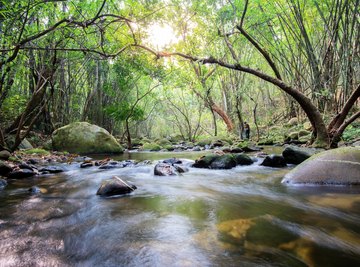
Streamflow is the measure of how much water flows in a stream at any given time. Measuring streamflow is a complicated process undertaken by teams of water scientists all over the world.
TL;DR (Too Long; Didn't Read)
To determine streamflow, water scientists take continuous measurements of a stream's stage height and periodic measurements of discharge. The relationship between this data, which they visualize using a graph and best-fit curve, represents streamflow.
Stream Stage Measurement
Water scientists measure stream stage, which is the same as stage height or gage height, using stage zero (a set height near the streambed) and a staff gage marked in 1/100th and 1/10th foot intervals to measure the height of the water surface. Taking continuous measurements allows experts to monitor for research and recreational purposes as well as making decisions about building, dam operation and water allocation. The US Geological Survey (USGS) first began measuring this way in 1889, which means they have a large body of compiled data to assist with these goals.
Of course, many of the USGS gaging tools are more complicated than a simple staff gage. One of the most common methods relies on a stilling well. This well allows water from the stream to enter the well where a float or sensor measures its stage (usually every 15 minutes) and stores that data.
Discharge Measurement
In addition to measuring stream stage, water scientists also periodically (usually ever 6 to 8 weeks) measure the amount of water that moves down the stream at a specific location, called discharge. This measurement requires them to multiply the area of water in a cross section of the stream by the average velocity of the water in that same cross section.
To do this, water scientists use a cable or wading rod to probe a section of a stream and measure its depth and width and calculate area (depth x width). This measurement is especially tricky in areas with fast-moving water or streams covered with ice.
Then, they use a current meter, which looks like a rod attached to a wheel, to measure how quickly the water moves by recording how many revolutions the wheel makes over time when immersed in the stream. For very deep water, water scientists sometimes use an acoustic doppler current meter, which uses sound frequency to make measurements.
Calculating Streamflow
Using these two pieces of information, stream stage and discharge, water scientists can use the relationship between stage and discharge to estimate streamflow. To do this, they plot the stage height and discharge measurements over time, and then construct a best-fit curve for the data points. The equation of that curve is the relationship between stream stage and discharge, or streamflow. Water scientists must make constant adjustments to their calculations that take into account the ways that the stream channel itself changes as a result of erosion, deposition, plant growth, debris and ice.
The USGS takes measurements and transmits that data via satellite then streams the information for the public on its website. Thanks to this technology, you can see the gage height, discharge and streamflow for any site in the U.S. in real time.
References
Warnings
- Do not enter fast moving water.
- Deep water can have strong under currents, so extreme care should be taken when entering any stream or river.
- Always have a second person with you when performing this procedure.
About the Author
Melissa Mayer is an eclectic science writer with experience in the fields of molecular biology, proteomics, genomics, microbiology, biobanking and food science. In the niche of science and medical writing, her work includes five years with Thermo Scientific (Accelerating Science blogs), SomaLogic, Mental Floss, the Society for Neuroscience and Healthline. She has also served as interim associate editor for a glossy trade magazine read by pathologists, Clinical Lab Products, and wrote a non-fiction YA book (Coping with Date Rape and Acquaintance Rape). She has two books forthcoming covering the neuroscience of mental health.
